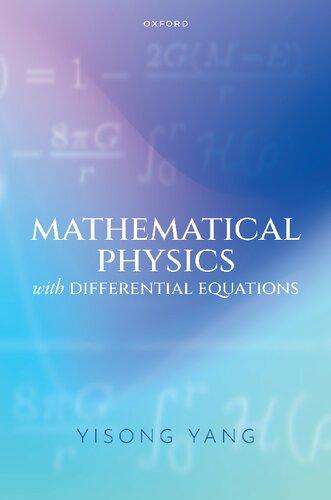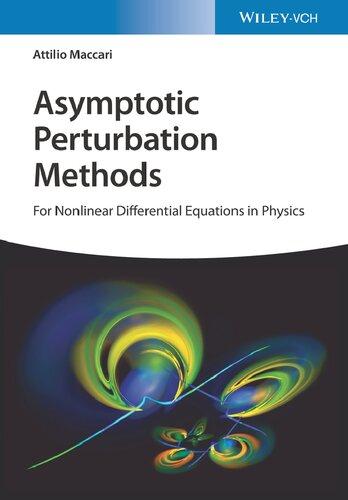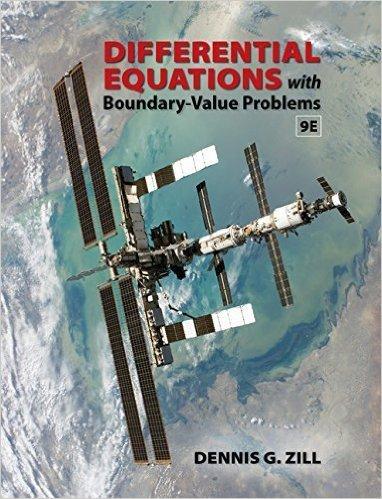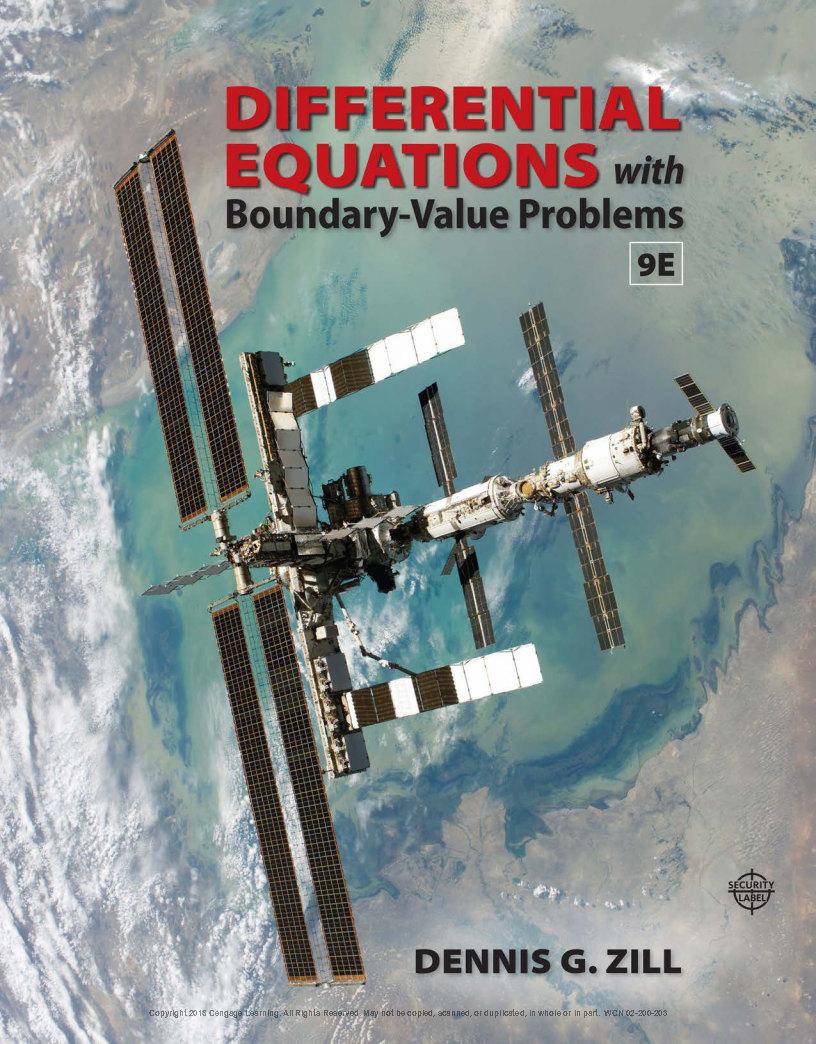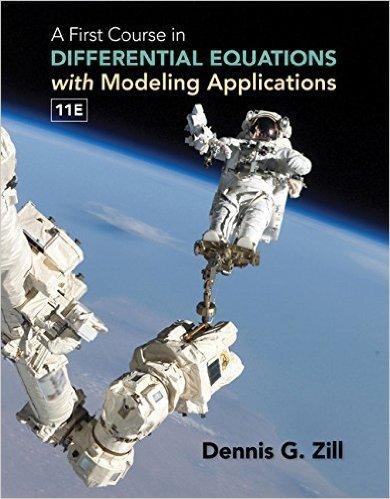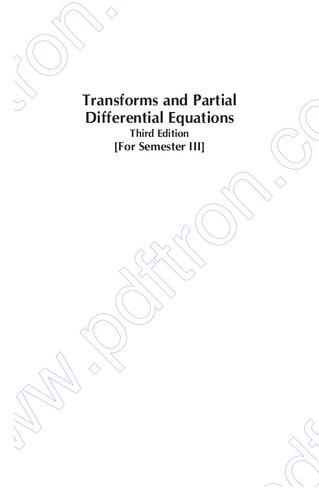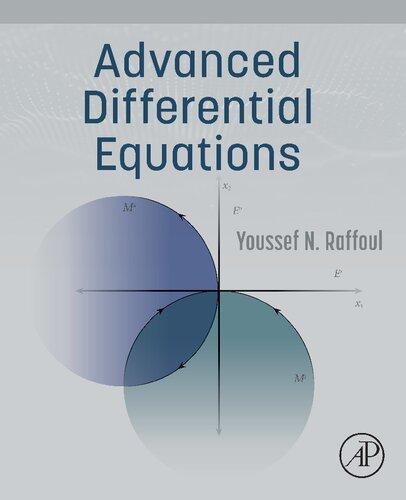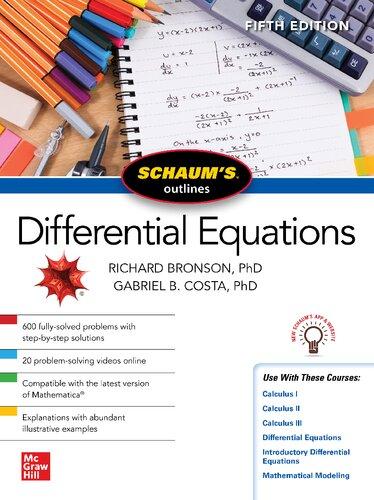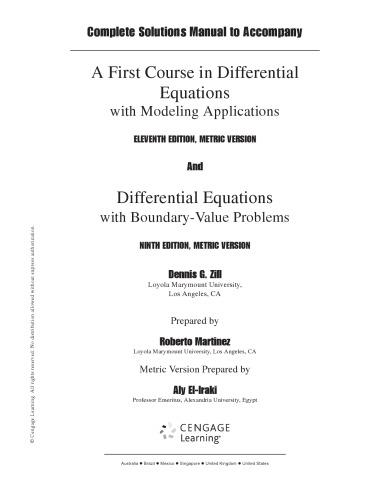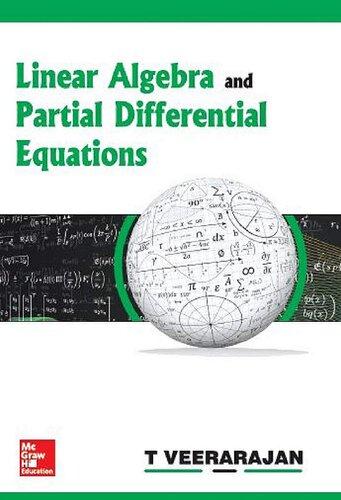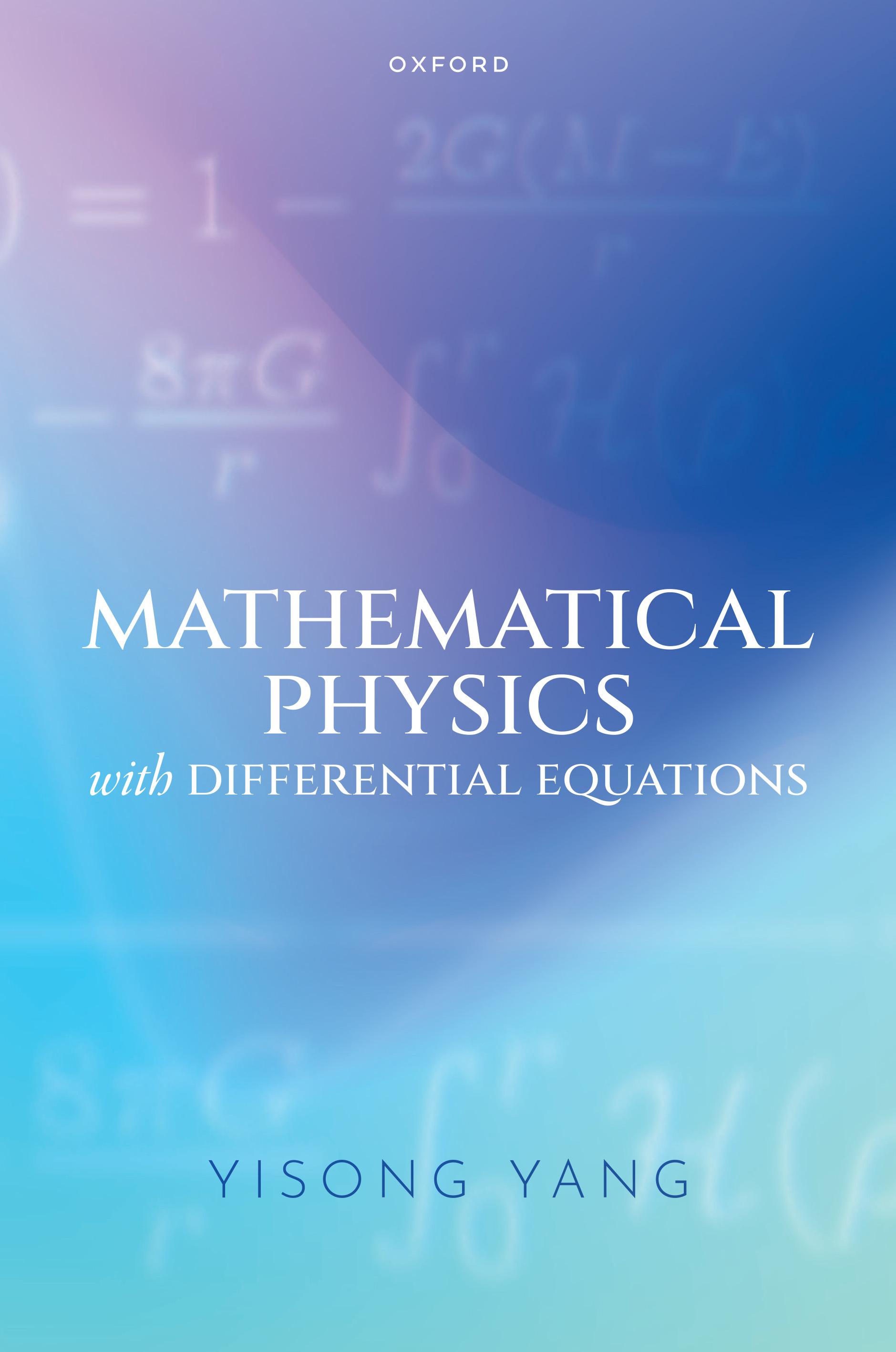Mathematical Physics with Differential Equations Yisong. Yang Visit to download the full and correct content document: https://ebookmass.com/product/mathematical-physics-with-differential-equations-yiso ng-yang/
More products digital (pdf, epub, mobi) instant download maybe you interests ...
Asymptotic Perturbation Methods: For Nonlinear Differential Equations in Physics Attilio Maccari
https://ebookmass.com/product/asymptotic-perturbation-methodsfor-nonlinear-differential-equations-in-physics-attilio-maccari/
eTextbook 978-1305965799 Differential Equations with Boundary-Value Problems
https://ebookmass.com/product/etextbook-978-1305965799differential-equations-with-boundary-value-problems/
Differential Equations with Boundary-Value Problems 9th Edition Dennis G. Zill
https://ebookmass.com/product/differential-equations-withboundary-value-problems-9th-edition-dennis-g-zill/
eTextbook 978-1305965720 A First Course in Differential Equations with Modeling Applications
https://ebookmass.com/product/etextbook-978-1305965720-a-firstcourse-in-differential-equations-with-modeling-applications/
Transforms and Partial Differential Equations T.
Veerarajan
https://ebookmass.com/product/transforms-and-partialdifferential-equations-t-veerarajan/
Advanced Differential Equations 1st Edition Youssef
Raffoul
https://ebookmass.com/product/advanced-differentialequations-1st-edition-youssef-raffoul/
Schaum's Outline of Differential Equations, Fifth Edition Bronson
https://ebookmass.com/product/schaums-outline-of-differentialequations-fifth-edition-bronson/
First Course in differential equations (11ed) / Differential Equations and Boundary Value Problems (9ed) Solutions manual Dennis Zill Roberto Martinez
https://ebookmass.com/product/first-course-in-differentialequations-11ed-differential-equations-and-boundary-valueproblems-9ed-solutions-manual-dennis-zill-roberto-martinez/
Linear Algebra and Partial Differential Equations T
Veerarajan
https://ebookmass.com/product/linear-algebra-and-partialdifferential-equations-t-veerarajan/
MathematicalPhysicswithDifferentialEquations
MathematicalPhysicswith DifferentialEquations YisongYang Professor,CourantInstituteofMathematicalSciences, NewYorkUniversity
GreatClarendonStreet,Oxford,OX26DP, UnitedKingdom
OxfordUniversityPressisadepartmentoftheUniversityofOxford. ItfurtherstheUniversity’sobjectiveofexcellenceinresearch,scholarship, andeducationbypublishingworldwide.Oxfordisaregisteredtrademarkof OxfordUniversityPressintheUKandincertainothercountries
©YisongYang2023
Themoralrightsoftheauthorhavebeenasserted Allrightsreserved.Nopartofthispublicationmaybereproduced,storedin aretrievalsystem,ortransmitted,inanyformorbyanymeans,withoutthe priorpermissioninwritingofOxfordUniversityPress,orasexpresslypermitted bylaw,bylicenceorundertermsagreedwiththeappropriatereprographics rightsorganization.Enquiriesconcerningreproductionoutsidethescopeofthe aboveshouldbesenttotheRightsDepartment,OxfordUniversityPress,atthe addressabove
Youmustnotcirculatethisworkinanyotherform andyoumustimposethissameconditiononanyacquirer
PublishedintheUnitedStatesofAmericabyOxfordUniversityPress 198MadisonAvenue,NewYork,NY10016,UnitedStatesofAmerica
BritishLibraryCataloguinginPublicationData Dataavailable
LibraryofCongressControlNumber:2022943690
ISBN978–0–19–287261–6 ISBN978–0–19–287262–3(pbk.)
DOI:10.1093/oso/9780192872616.001.0001
Printedandboundby
CPIGroup(UK)Ltd,Croydon,CR04YY
LinkstothirdpartywebsitesareprovidedbyOxfordingoodfaithand forinformationonly.Oxforddisclaimsanyresponsibilityforthematerials containedinanythirdpartywebsitereferencedinthiswork.
ForSheng, Peter,Anna,andJulia
4.1Inertialframes,Minkowskispacetime, andLorentzboosts
5.1Spacetime,covariance,andinvariance
5.2Relativisticfieldequations
5.3Couplednonlinearhyperbolicandelliptic equations
6.4Diracequationcoupledwithgauge field
6.5DiracequationinWeylrepresentation
7.1Perfectconductors,superconductors, andLondonequations
8.1Energypartition,fluxquantization, andtopologicalproperties
8.2Vortex-lines,solitons,andparticles
9Non-Abeliangaugefieldequations
dyon
10Einsteinequationsandrelatedtopics
11ChargedvorticesandChern–Simonsequations
13Stringsandbranes
13.1Motivationandrelativisticmotionoffree particleasinitialsetup
13.2Nambu–Gotostrings
13.3 p-branes
14Born–Infeldtheoryofelectromagnetism
ofpointcharges
Preface Thisbookaimstopresentabroadrangeoffundamentaltopicsintheoretical andmathematicalphysicsinathoroughandtransparentmannerbasedonthe viewpointofdifferentialequations.Thesubjectareascoveredincludeclassical andquantummany-bodyproblems,thermodynamics,electromagnetism, magneticmonopoles,specialrelativity,gaugefieldtheories,generalrelativity, superconductivity,vorticesandothertopologicalsolitons,andcanonical quantizationoffields,forwhich,differentialequationsareessentialfor comprehensionandhaveplayed,andwillcontinuetoplayimportantroles. Overthepastdecade,theauthorhasusedmostofthesetopicsatseveral universities,domesticallyandinternationally,ascoursesandseminarsmainly formathematicalgraduatestudentsandresearcherstrainedandinterestedin differentialequations.Theseactivitiesandexperiencesconvincedtheauthor thatmanyoftheconcepts,construction,structures,ideas,andinsightsof fundamentalphysicscanbetaughtandlearnedeffectivelyandproductively, withemphasisonwhatareofferedbyordemandedfromdifferentialequations.
Withthisinmind,thebookhasseveralgoalstoaccomplish.Firstly,thestyle ofthepresentationhopefullyprovidesahandyanddirectaccesstoapproach thesubjectsdiscussed.Secondly,itservestorenderafairlywideselection ofthemesthatmayfurtherbetailoredforagraduate-levelmathematical physicscurriculumoutoftheindividualpreferenceoftheinstructororreader. Thirdly,itsuppliesabalancedpooloftopicsforupper-levelorhonors undergraduateseminars.Fourthly,itoffersguidanceandstimulationtothe relatedcontemporaryresearchfrontiersandliterature.
Exceptforknowledgeondifferentialequations,theprerequisiteforthereader ofthebookiskeptminimal,althoughcertainlevelsofacquaintancewith undergraduategeneralphysicsishelpfulforthereadertoproceedsmoothly. Thus,thebookbeginswithclassicalmechanicsincanonicalformalismandmoves ontovariousadvancedsubjects.However,unlessneeded,thebookexcludes specializedtopicsoftraditionalclassicalmechanicssuchasfluidsandelasticity theories,sincetheyaretreatedextensivelyelsewhereintheliterature.The bookmaybeusedforself-study,asatextbook,orasasupplementalsource bookforacourseinmathematicalphysicswithconcentrationandinterestsin quantummechanics,fieldtheory,andgeneralrelativity,emphasizinginsights fromdifferentialequations.
Whilethebookholdsfifteenchapters,eachchaptermaybestudiedor presentedseparatelyinamoreorlessself-containedmanner,dependingon interestsandreadinessofthereaderoraudience.
InChapter 1,westartwithapresentationofthecanonicalformalismof classicalmechanics.Wethenconsidertheclassicalmany-bodyproblemsin three-,two-,andone-dimensionalsettings,subsequently.Specifically,inthree dimensions,wediscussthemany-bodyproblemgovernedbyNewton’sgravity, consolidatedbyathoroughstudyofKepler’slawsofplanetarymotionanda derivationofNewton’slawofgravitation,asaby-product;intwodimensions,we introducetheHelmholtz–Kirchhoffpoint-vortexmodel;and,inonedimension, wepresentadynamicalsystemprobleminbiophysicsknownastheDNA denaturation.Forthisthirdsubjectwealsoexplainhowtoimplementideas ofthermodynamicstostudyatemperature-dependentmechanicalsystem.The goalofthischapteristolayaLagrangianfield-theoreticalfoundationforfield theoryandenlightenthestudywithsomeexemplaryapplications.
InChapter 2,weconsiderquantummany-bodyproblems.Weexplainhowthe Schrödingerequationisconceptualizedandthestatisticalinterpretationofthe wavefunction.Then,weformulatethequantummany-bodyproblemdescribing anatomicsystemanddiscussthehydrogenmodelasanillustration.Next, weshowhowtheHartree–Fockmethod,Thomas–Fermiapproach,anddensity functionaltheorymaybeutilizedinvarioussituationsascomputationaltoolsto findthegroundstatesolutionofaquantummany-bodyproblem.Aninitialgoal ofthischapteristoillustrateamonumentaltransitionfromclassicaltoquantum mechanicsbasedontheSchrödingerequationrealizationofthephotoelectric effect.Asecondgoalofthischapteristointroducesomemathematicalchallenges presentedbyquantummany-bodyproblems.Herethestudyofthehydrogen modelservesasamotivatingstartingpointofthequantummany-bodyproblem, whichnaturallyleadstothedevelopmentofsubsequentanalyticmethodsof computationalsignificancewhenthedimensionoftheproblemgoesup.In particular,weshowthatthequantum-mechanicaldescriptionofamany-body problem,whoseclassical-mechanicalbehaviorisgovernedbynonlinearordinary differentialequations,isnowgivenbyalinearpartialdifferentialequation, andthatappropriateapproximationsofsuchalinearequationnecessitatethe formulationofvariousnonlinearequationproblemsinrespectivelyspecialized situations.
Chapter 3 isastudyoftheMaxwellequationsandsomedistinguished consequences.First,wepresenttheequationsanddiscusstheassociated electromagneticdualityphenomenon.WenextformulatetheDiracmonopole andDiracstringsandshowhowtouseagaugefieldtoresolvetheDiracstring puzzleandobtainDirac’schargequantizationformula.Wedemonstratehowthis ideainspiredSchwingertoderiveageneralizedquantizationformulaforaparticle carryingbothelectricandmagneticcharges,knownasdyon.Wethenpresentthe Aharonov–Bohmeffectforwaveinterference,whichdemonstratesthesignificant rolesplayedbythegaugefieldandtopologyofasystematquantumlevel.The goalofthischapteristoappreciatehowsomeofthefundamentalandrich contentsofelectromagneticinteractionmaybeinvestigatedproductivelythrough exploringthestructuresofthedifferentialequationsgoverningtheinteraction.
Specifically,bycomplexifyingthewaveequation,weobtainanovelderivation oftheMaxwellequations,whichalsoembodiesaclearandnaturalrevelationof theelectromagneticduality,and,byconsideringthetopologicalpropertiesofthe solutionstotheMaxwellequations,wearriveatthefindingsofDirac,Schwinger, andAharonov–Bohm.
Chapter 4 isasuccinctintroductiontospecialrelativity.Sincemostofthe subjectscoveredinthistextareconcernedwithrelativisticfieldequations,some solidknowledgeonspecialrelativityisnecessary.Thuswecarryoutastudy ofspecialrelativityinthischapter.Wefirstdiscussspacetime,inertialframes, andtheLorentztransformations.Wepresenttopicsthatincludespacetimeline element,propertime,andaseriesofnotions,includinglengthcontraction,time dilation,andsimultaneityofevents.Then,westudyrelativisticmechanics. Althoughthischapterisshort,itsgoalistoserveasthefoundationfor manyfollowingchapters,includingthoseontheDiracequations,gaugefield theory,generalrelativity,andtopologicalsolitons.Inparticular,theLagrangian actionforthemotionofarelativisticparticlewillbethestartingpointforthe formulationoftheNambu–GotostringactionandtheBorn–Infeldtheory.
InChapter 5,wepresenttheAbeliangaugefieldtheory.Westartwithan introductiontothenotionsofcovariance,contravariance,andinvariancefor quantitiesdefinedoveraspacetime.WeformulatetheKlein–Gordonequation, whichisarelativisticextensionoftheSchrödingerequation.Wethenshow thatagaugefieldisbroughtupagainnaturallyinordertopromotetheinternal symmetryofthesystemfromglobaltolocalsuchthattheMaxwellequationsare deducedasaconsequence.Furthermore,wediscussvariousconceptsofsymmetry breakingandillustratetheideasoftheHiggsmechanismasanotherimportant applicationofgaugefieldequations.Agoalachievedinthischapteristhata vistaofimportantphysicalconsequencesmaybeobtainedfromexaminingsome basicstructuralaspectsoftheequationsofmotionwithoutsufficientknowledge abouttheirsolutions.
Chapter 6 centersaroundtheDiracequation.Wefirstshowhowtoobtainthe classicalDiracequationandwhatimmediateconsequencestheequationoffers incontrasttotheKlein–Gordonequation.WenextconsidertheDiracequation coupledwithagaugefieldandpresentitsSchrödingerequationapproximations inelectrostaticandmagnetostaticlimits,respectively.Inparticular,wederive theStern–Gerlachterm,whosepresenceisessentialfortheexplanationofthe Zeemaneffect.WethenreviewsomenonlinearDiracequations.Thisstudy showsthatsometimesprofoundphysicsmaybeunveiledunexpectedlythrough anexplorationofsomedeeplyhiddeninternalstructuresofthegoverning equations.
Chapter 7 coverstheGinzburg–Landautheoryforsuperconductivity.We beginwithadiscussionofperfectconductors,superconductors,theMeissner effect,theLondonequations,andthePippardequation.Wenextpresentthe Ginzburg–Landauequationsforsuperconductivityandshowhowtocomeup withtheLondonequationsintheuniformorder-parameterlimitanddemonstrate theMeissnereffect.Wethenstudytheclassificationofsuperconductivityin viewofsurfaceenergyanddiscusstheappearanceofmixedstatesintype IIsuperconductors.Weendthechapterwithareviewofsomegeneralized
Ginzburg–Landauequations.Thisstudyretracesthehistoricalpathregarding howdifferentialequationsofvariedsubtletieshavebeenexploitedinlinewith real-worldobservationstoadvancetheunderstandingofsuperconductivity. Inparticular,italsodescribesanunsolvedtwo-pointboundaryvalue problem,arisingintheGinzburg–Landautheory,fortheclassificationof superconductivity.
Chapter 8 growsoutofthesubjectscoveredinChapter5andChapter7. Specifically,inthischapter,wefocusonthestaticAbelianHiggstheoryorthe Ginzburg–Landautheoryintwodimensions,whichpossessesadistinctiveclass ofmixed-statesolutionsofatopologicalcharacteristicknownasvortices.We describesuchsolutionsindetailinviewofseveralimportantfacetsincluding energyconcentration,vortex-linedistribution,quantizationofmagneticfluxor charge,andexponentialdecayproperties.Wealsodiscusstheuseofsuchvortexlinesolutionsinalinearconfinementmechanismformagneticmonopoles,a topicactivelypursuedinquarkconfinementresearchinrecentyears.Thisstudy showsagaintheapplicationsofsolutionsofgaugefieldequations,oftopological characteristics,tofundamentalphysics,ofbothquantitativeandconceptual values.
InChapter 9,wemoveontothesubjectofnon-Abeliangaugefieldtheory. Wefirstpresentthetheoryonagenerallevel,andthenspecializeonthe Yang–Mills–Higgstheory.Wediscussaseriesofconcreteformalismsincluding theGeorgi–GlashowmodelandtheWeinberg–Salamelectroweaktheory.We alsoillustratesomeimportantfamiliesofsolutionssuchasthe’tHooft–Polyakovmonopole,Julia–Zeedyon,andBogomol’nyi–Prasad–Sommerfield explicitsolution.Themaingoalofthischapteristopresentabroadfamily ofnonlinearpartialdifferentialequationsofimportanceinelementaryparticle physics.
InChapter 10,westudytheEinsteinequationsofgeneralrelativityand relatedsubjects.WebeginwithanintroductiontothebasicsofRiemannian geometryandthenpresenttheEinsteintensorandtheEinsteinequations forgravitation.Subsequently,weunfoldourdiscussionmainlyaroundspecial solutionsoftheEinsteinequations,categorizedintotime-dependentspaceuniformsolutionsandtime-independentspace-symmetricsolutions.Inthe formercategory,weelaborateonthecosmologicalconsequencesandimplications richlycontainedinvarioussolutionsoftheFriedmanntypeequationsunderthe Robertson–Walkermetric,whichincludetheBigBangcosmologicalscenario, patternsofexpansionoftheuniverse,andanestimateoftheageoftheuniverse. Inthelattercategory,webeginwithapresentationoftheSchwarzschildsolution andadiscussionofseveralnotionsunveiled,suchastheeventhorizonand blackhole.WethenpresentaderivationoftheReissner–Nordströmsolution forablackholecarryingbothelectricandmagneticchargesanddiscussits consequences.WewillalsodiscusstheKerrsolutiondescribingarotatingblack hole.Afterwards,weconsiderthegravitationalmassproblemandthePenrose boundsasadditionalthemes.Wenextpresentadiscussionofgravitationalwaves intheweak-fieldlimit.Weconcludethechapterwithastudyofthecosmological expansionofanisotropicandhomogeneousuniversepropelledbyascalar-wave
matterknownasquintessence.ThemaingoalofthischapteristousetheEinstein equationsasakeytoaccessabroadrangeofgravity-relatedresearchdirections ofcontemporaryinterests.
Chapter 11 isaboutchargedvorticesandtheChern–Simonsequations.For conciseness,wefocusonthesimplestAbeliansituations.Wefirstpresentthe Julia–Zeetheoremanditsproof,whichstatesthatfinite-energyelectrically chargedvortices,whicharestaticsolutionsintwodimensions,donotexistin theusualYang–Mills–Higgstheory.Thus,somemodificationofthetheoryis tobemadeinordertoaccommodatechargedvortices,andtheadditionofa Chern–SimonstopologicaltermtotheLagrangianactiondensitywillservethe purpose.Inthischapter,ourgoalistopresentabriefintroductiontotheChern–Simonsvortexequations.Besidesthemotivationforallowingelectricallycharged vortices,otherapplicationsoftheChern–Simonstheoryincludeanyonphysics ofcondensedmatters,gravitytheory,andhigh-temperaturesuperconductivity, wherenon-Abelianstructuresarealsoabundantlyutilized.Itishopedthat thisintroductionwillservetosparkinterestandinspirationinthestudyof anenormousfamilyofpartialdifferentialequationproblemsofchallenges,under thesharedtitleoftheChern–Simonsvortexequations.
InChapter 12,weconsidertheSkyrmemodelandsomerelatedtopics.We beginwithanexplorationofthewell-knowndimensionalityconstraintsbrought forthbytheDerricktheoremandthePohozaevidentity.Wethenintroduce theSkyrmemodeltomaneuveraroundthedimensionalityconstraints.Asa relatedtopic,wewillalsodiscusstheFaddeevmodel,whichmaybeviewed asadescentoftheSkyrmemodelandwhichbringsaboutknot-likesolutions characterizedbyfractionally-poweredgrowthlawsrelatingenergytotopology. Inaddition,wepresentadiscussionofColeman’sQ-ballmodel,whichalsohasno dimensionalityrestriction.Duetothedifficultiesassociatedwiththestructuresof thenonlinearitiesandtopologicalcharacteristicsofthesefield-theoreticalmodels, ithasbeenadauntingtasktoconsidertheequationsofmotiondirectly,except innumericalstudies,andoneneedstofocusontheirvariationalsolutions.In eithersituation,hopefullythischapterservesasaninvitationtomanyrelated researchtopics.
Chapter 13 isashortdiscussiononstringsandbranes.Wefirstrevisitthe relativisticmotionofafreeparticleandsubsequentlyformulatetheNambu–Gotostringequations.Wethenextendthestudytoconsiderbranesandtheir governingequations.WenextpresentthePolyakovstringsandbranesand theirequationsofmotion.Thus,ourgoalofthischapteristoemphasizethe challengesanddifficultiesencounteredinthesehighlygeometricandnonlinear partialdifferentialequationsasclassicalfield-theoryequations.Exceptin someextremelysimplifiedorreducedlimits,theseequationsarenotyetwell understood,regardingtheirsolutions.
InChapter 14,wepresenttheBorn–Infeldtheoryofelectromagnetismand someoftheassociatedmathematicalproblems.Tostart,werecalltheenergy divergenceproblemofthepoint-chargemodeloftheelectronandtheideaof BornandInfeldintacklingtheproblembasedonarevisionoftheactiondensity motivatedbyspecialrelativity,sometimesreferredtoasthefirstformulationof
BornandInfeld.Withinthisformalism,weconsidersomeinterestingillustrative calculationsaroundtheelectricanddyonicpointchargeproblems.Wenext presentthesecondformulationofBorn–Infeldbasedoninvarianceconsideration andshowhowtoresolvetheenergydivergenceproblemassociatedwithadyonic pointchargeencounteredinthefirstformulationofBornandInfeld.Wethen relatetheBorn–Infeldequationstotheminimalsurfaceequationsandpropose somegeneralizedBernsteinproblems.Subsequently,weconductadiscussion ofaninteger-squaredlawofauniversalnatureregardingtheglobalvortex solutionsoftheBorn–Infeldequationsintwodimensions.Furthermore,we alsopresentaseriesofelectricallyanddyonicallychargedblackholesolutions oftheEinsteinequationscoupledwiththeBorn–Infeldequations.Thereafter, weconsiderthegeneralizedBorn–Infeldtheoriesandpresentsomeinteresting applications,includinganonlinearmechanismforanexclusionofmonopoles asfinite-energymagneticallychargedpointparticles,relegationandremovalof curvaturesingularitiesofchargedblackholesoftheReissner–Nordströmtype, andtheoreticalrealizationsofcosmologicalexpansionandequationsofstateof cosmologicalfluidsthroughappropriateBorn–Infeldscalar-wavemattersinthe formofk-essence.Insomesense,thischaptermayberegardedasagaugefieldorscalar-fieldextensionofthesubjectsdiscussedinChapter13.Therefore, thedifficultiesweencounterherearesimilartothosethere.Ontheother hand,withinthelimitationoftheBorn–Infeldtheory,hereweareableto seehowrealprogressismadeformanyimportantissuesofconcern,suchas theresolutionofanelectricpointchargeofdivergentenergy,electromagnetic asymmetry,singularityrelegationforchargedblackholes,andk-essencescalar fieldcosmology,allbasedonpursuingspecialsolutionsofthegoverningequations invarioussituations.
Chapter 15 isthefinalchapterandprovidessometasteoffieldquantization andafurtherviewexpansion.Forclarityandconciseness,ourdiscussion willbeclusteredaroundharmonicoscillators.Westartwithastudyofthe quantummechanicsofharmonicoscillatorsbasedoncanonicalquantization. WenextconsidertheHamiltonianformalismofgeneralfieldequationsinterms offunctionalderivativeandcommutators.Wethenshowhowtoquantizethe Klein–GordonequationandtheSchrödingerequation.Indoingso,weencounter thewell-knowninfinityproblemarisingfromadivergentzero-pointenergy, whichgivesusanopportunitytoexplaintheconceptofrenormalization.We thenmoveontoquantizetheMaxwellequationsthatgovernelectromagnetic fieldspropagatinginfreespace.Wefocusourattentiononthequantization ofenergy,momentum,andspinangularmomentumdirectly,ratherthan theelectromagneticfieldsthemselves,andderivethePlanck–Einsteinand Compton–Debyeformulasforthephotoelectriceffectandphotonspininthe contextofquantumfieldtheory.Weconcludethechapterwithadiscussion ofthethermodynamicsofaharmonicoscillator,bothclassicallyandquantum mechanically,suchthatweareabletocomeupwithapictureabouttherelation, rangesofapplicabilityandlimitation,andtransitionwithregardtotemperature, ofclassicalandquantum-mechanicaldescriptionsofaphysicalsystem,ingeneral. Thus,partofthegoalofthischapteristoshowinviewofquantumfieldtheory
whatmaybeexpectedbeyondclassicalfieldequationsbothinsenseofdifferential equationsandmeaningofquantumphysics.
Exercisesappearattheendofeachchapter.Thesemostlystraightforward problemsserveeithertosupplementthedetailsorexpandthescopeofthe materialsofthetext.Workingoutsomeoftheproblemsmaybeusefulfor checkingtheunderstandingofthesubjectscoveredbutomittingthisprocess shouldnotcompromisethequalityoflearningtoomuchsincethroughoutthe textthematerialsarepresentedinsufficientdetailsandelaboration.
Anidealreaderofthisbookisapersonwellversedincollege-leveldifferential equationswhoismotivatedbyphysicalapplicationsandisinterestedingaining insightsintofield-theoreticalphysicsthroughdifferentialequations.Inorderto keepthevolumeofthebooktoareasonablesize,weleaveoutintroductory materialsaboutbasicphysicalconceptscommonlycoveredinanundergraduate courseingeneralphysics.Forexample,whenwediscusstheGinzburg–Landau theoryofsuperconductivity,weassumethereaderknowswhatasuperconductor isandhowitbehaves.Thus,ifthisbookisusedasatextbookforashortor extensivecourse,itwillservethepurposebetterifitissupplementedwithsome extraconceptualnontechnicalreadingmaterials,whichshouldbeeasilyavailable.
Inadditiontoservingforself-study,thematerialscoveredinthebookare plannedinsuchawaythateachofthechaptersmaybeusedforashort concentratedtopiccourserangingfromtwotosevenweeksorlonger,withabout twotothreehoursoflecturesperweek.Specifically,Chapters1,3–9,11,and 13maybecandidatesforatwo-weekcourse,Chapters2,12,and15forathreetofour-weekcourse,andChapters10and14forasix-toseven-weekcourse. Foraone-semestercourse,theauthorsuggestspickingacollectionofaboutsix tosevenchaptersdependingontheinterestsoftheinstructorandstudents.At anelementarylevel,achoicemaybeChapters1–4,Chapter7,Chapter8,and Chapter11,supplementedwithSection5.1ifnecessary.Atamoreadvanced level,achoicemaybeChapters5–10andChapter15.Thematerialsofthefull bookaremorethanenoughforayear-longcourse.Moreover,exceptforChapters 4and15,allotherchaptersmaybestudiedforresearchtopicsandprojectsof differentialequationsandnonlinearanalysisintheoreticalandmathematical physics.
WesupplementthebookwithanAppendiceschapterofsixsections,which coversomeconceptsandsubjectsencounteredandusedelsewhereinthemain text.Inthefirstsection,wegiveafullintroductiontothenotionsofindices ofvectorfieldsandtopologicaldegreesofmaps,inthecontextoftheEuclidean spaces.Webeginourdiscussionfromtheargumentprincipleincomplexanalysis andthenextendtheconstructiontorealsituations,highlightedwithsome applicationsasexamples,includingaproofofthefundamentaltheoremof algebraandastudyoftheissueofexistenceandnon-existenceofperiodicorbits ofsomedynamicalsystems.Subsequently,wedeveloptheconceptsinhigher dimensionsandconcludethediscussionwithaproofoftheBrouwerfixed-point theorem.Inthesecondsection,weconsidertheconceptsoflinkingnumber andtheHopfinvariantbasedonourknowledgeonthetopologicaldegreeof amap.Wethenconsidertheseconstructionsinviewoftheconceptsofthe
helicityofavectorfield,theChern–Simonsinvariant,andtheclassicalintegral representationoftheHopfinvariantbyWhitehead.Inthethirdsection,we presentacomprehensivediscussionoftheNoethertheorem,whichassociates continuoussymmetriesofaLagrangianmechanicalorfield-theoreticalsystem withitsconservedquantitiesschematically.Asillustrations,wefirstconsider themotionofapointmassandderiveitsenergy,linearmomenta,and angularmomenta,asconsequencesoftime-andspace-translationinvarianceand rotation-invariance.Wethendeveloptheformalisminthesettingofageneral Lagrangianfield-theoreticalframeworkandshowhowtoconstructtheassociated energy-momentumtensorandvariousNoetherchargesandcurrents.Inthe fourthsection,wedescribethepossibleeigenvaluesoftheangularmomentum operatorsofaparticleinnon-relativisticquantum-mechanicalmotionbasedon theassociatedcommutationrelationsoftheseoperators.Asaby-product,we explainhowtodeduceDirac’schargequantizationformulausingSaha’smethod withoutresortingtoatreatmentoftheDiracstrings.Inthefifthsection,we showhowtheconceptoftheintrinsicspinofaparticleinquantum-mechanical motionarisesasaresultof“correcting”a“deficiency”inthespectraoforbital quantummomentumoperators.Asaconsequence,wearenaturallyledtothe introductionofspinmatricesandspinors.Inparticular,weshowhowthePauli spinmatricesarecalledupon,andthenexplainhowtheparticlespinsarerelated toparticlestatisticsandclassificationbyvirtueofthespin-statisticstheorem. Inthesixthsection,wepresentacomprehensivediscussionontheproblem ofgravitationaldeflectionoflightnearamassivecelestialbody.Webeginby consideringthelightdeflectionprobleminthecontextofNewtoniangravity andderivetheassociatedbendingangle.Wethenstudythegeodesicequations forthemotionofaphotonsubjecttotheSchwarzschildblackholemetricand deduceEinstein’sdeflectionangle,thatexactlydoublesthatofNewtonandwas famouslyconfirmedbyDyson,Eddington,andDavidsonin1919.
Thus,thesesectionsmaybeclusteredintofoursubgroups.Thefirstsubgroup consistsofthefirsttwosectionsandconcernswithsometopologicalconceptsand constructions;thesecondsubgroupismadeofthesubsequentsectionthatfocuses onconservationlawsinrelationtocontinuoussymmetriesinasystem;thethird subgroupiscomprisedofthenexttwosectionsandaddressesissuesaroundthe eigenvaluesofangularmomentumoperatorsandspinsofparticles;thefourth subgroup,whichisthelastsectionofthischapterandsupplementsChapter1 looselyandChapter10tightly,isastudyofthegravitationallightdeflection phenomenon.Eachofthesefoursubgroupsofsubjectsmaybeofindependent interesttosomereaders.Asintherestofthebook,exercisesappearattheend ofthechapter.
TheauthorthanksSvenBjarkeGudnason,LucianoMedina,WenxuanTao, andTigranTchrakianforsomeconstructivecommentsandsuggestions,andDan TaberofOxfordUniversityPressforvaluableeditorialsuggestionsandadvice, whichhelpedimprovethepresentationandorganizationofthecontentsofthe book.
Author WestWindsor,NewJersey
NotationandConvention Weuse N todenotethesetofallnaturalnumbers,
N = {0, 1, 2,... }, and Z thesetofallintegers,
Z = {..., 2, 1, 0, 1, 2,... }.
Weuse R and C todenotethesetsofrealandcomplexnumbers,respectively.
Weusetheromantypeletteritodenotetheimaginaryunit √ 1.Fora complexnumber c = a + ib where a and b arerealnumbersweuse
c = a ib
todenotethecomplexconjugateof c.WeuseRe{c} andIm{c} todenotethe realandimaginarypartsofthecomplexnumber c = a + ib.Thatis,
Re{c} = a, Im{c} = b.
Thesignatureofan (n +1)-dimensionalMinkowskispacetimeisalways (+ ···−).The (n +1)-dimensionalflatMinkowskispacetimeisdenotedby Rn,1 and isequippedwiththescalarproduct xy = x 0 y 0
1 y 1
xnyn ,
where x =(x0,x1,...,xn) and y =(y0,y1,...,yn) ∈ Rn,1 arespacetimevectors. Unlessotherwisestated,wealwaysusetheGreekletters α,β,µ,ν todenote thespacetimeindices, α,β,µ,ν =0, 1, 2,...,n, andtheLatinletters i,j,k,l todenotethespaceindices, i,j,k,l =1, 2,...,n.
Weuse t todenotethevariableinapolynomialorafunctionorthetranspose operationonavectororamatrix.
Whenanexpression,say X or Y ,isgiven,weuse X ≡ Y todenotethat Y , or X,isdefinedtobe X,or Y ,respectively.
Occasionally,weusethesymbol ∀ toexpress“forall”,and ∃,toexpress “thereexists”.
Weuse [, ] todenotethecommutatorsoperatedonsuitable“quantities”so that [A,B]= AB BA,A
andsoon.
Weobservethesummationconventionoverrepeatedindicesunlessotherwise stated.Forexample,
TheromantypelettereisreservedtodenotetheEulernumberorthebaseof thenaturallogarithmicsystemandtheitalictypeletter e todenoteanirrelevant physicalcouplingconstantsuchasthechargeofthepositron( e willthenbe thechargeoftheelectron).Theromantypeletterddenotesthedifferentialand theitalictypeletter d denotesa“quantity”,inmathematicaldisplaymode. Thereferencesinbibliographyandtheircitationsintextfollowalphabetic ordersbythelastnamesoftheauthors.
AlthoughtheGreekletters µ,ν,etc.,denotetheindicesofthespacetime coordinates,occasionally,theyarealsousedtodenotetheRadonmeasuresor someparametersinothercontexts,whenthereisnoriskofconfusionbutthere isaneedtobeconsistentwithliterature.Furthermore,sometimes ν isusedto denotetheoutnormaltotheboundaryofaboundeddomain.
Theunitspherecenteredattheorigin,in Rn (n =2, 3,... ),isdenotedby Sn 1 .
Theareaelementofasurfacesuchastheboundaryofaspatialdomainis oftendenotedbydσ.However,theLebesguemeasureofadomainforintegration issometimesomittedtosavespacewhenthereisnoriskofconfusion.
Let S beasetoffinitelymanypoints.Weuse |S| or#S todenotethenumber ofpointsin S.
Let S beasubsetoftheset T inacertainspace.Weuse T \ S todenotethe complementof S in T ,orsimply Sc when T isthefullspace.
Weusetheromantypeabbreviationsupptodenotethesupportofafunction.
Theletter C willbeusedtodenoteapositiveconstantwhichmayassume differentvaluesatdifferentplaces.
Foracomplexmatrix A,weuse A† todenoteitsHermitianconjugate,which consistsofamatrixtranspositionandacomplexconjugation.
Thesymbol W k,p denotestheSobolevspaceoffunctionswhosedistributional derivativesuptothe kthorderareallinthespace Lp . Byconvention,variousmatrixLiealgebrasaredenotedbylowercaseletters. Forexample,theLiealgebrasoftheLiegroups SO(N ) and SU (N ) aredenoted by so(N ) and su(N ),respectively.
Thenotationforvariousderivativesisasfollows,
Besides,withthecomplexvariable z = x1 + ix2,wealwaysunderstandthat ∂z = ∂ ∂z = ∂,∂z = ∂ ∂z = ∂.Thus,foranyfunction f thatonlyhaspartial derivativeswithrespectto x1 and x2,thequantities ∂zf = ∂f ∂z and ∂z = ∂f ∂z are welldefined.
Vectorsandtensorsareoftensimplydenotedbytheirgeneralcomponents, respectively,followingphysicsliterature.Forexample,itisunderstoodthat
Inavolumeofthisscope,itisinevitabletohavealettertocarrydifferent butstandardmeaningsindifferentcontexts,althoughsuchamultipleusage oflettershasbeenkepttoaminimum.Herearesomeexamples.TheGreek letter ν usuallydenotesaspacetimecoordinateindexbutalsostandsforaunit normalvectortoasurface; δ maystandforasmallpositivenumber,variation ofafunctional,ortheDiracdistribution,and δij istheKroneckersymbol; g maystandforacouplingconstantsuchasamagneticcharge,ametrictensor oritsdeterminant,orafunction; x maydenotethecoordinateofapointin therealaxisorapointinspaceorspacetime; P maydenoteamagneticcharge oramomentumvector; G usuallystandsforNewton’suniversalgravitational constantbutmayalsodenotesaLiegrouporafunction; ρ usuallystandsfor acharge,mass,probability,orenergydensity,butmayalsodenotesaradial variableorradialcoordinateunderconsideration;thelowercaseletter c usually denotesthespeedoflightinvacuumbutalsooccasionallyaconstantthatshould bemadeclearinthecontext.
Forconvenience,wesometimesuse x todenoteapointin R3 or Rn ingeneral. Weuse ∇× F andcurlF,and, ∇· F anddivF,interchangeablyforthecurland divergenceoperations,respectively,onavectorfield F over R3.Foran Rn-valued vector,say A,weuse A and |A| alternativelytodenotethelengthornormof A withrespecttotheEuclideanscalarproduct · of Rn suchthat A · A = |A|2 isalsorewrittenas A2 concisely.
Forapositivequantityorvariable,say, r,weuse r 1 or r 1 todenote theassumptionthat r issufficientlysmallorlarge,respectively.
Weusetheoverdot todenotedifferentiationwithrespecttoa“time variable”, t,andtheprime ′ differentiationwithrespecttosomeothervariable, whichshouldbeself-evidentfromthecontext.Alternatively,wealsouse ′ to denoteaquantitythatisavariationofanoriginalonefollowingaspecificrule orunderstanding.
Alldisplayedmathematicalexpressionsarenumberedregardlesswhetherthey arereferredtointhetextforthesakeofconvenienceofthereaderincaseany needoftheirreferenceiscalledonwhileusingthebook.
Insomechapters,thefirstsectionsalsoservetobrieflysurveythesubjects tobecoveredinthesubsequentsections.
1 Hamiltoniansystems andapplications ThischapterfirstintroducestheHamiltonianorLagrangianformalismof classicalmechanics,whichistheconceptualfoundationofalllaterdevelopments. Asillustrationsofapplications,itthenpresentsafewimportantmany-body problems.Amongthese,itfirstdiscussestheclassical N -bodyproblemin R3 and nextconsidersKepler’slawsofplanetarymotionasanimportantapplicationof theformalismandderiveNewton’slawofgravitationasaby-product.Itthen presentstheHelmholtz–Kirchhoffpointvortexproblem,whichmayberegarded asan N -bodyproblemin R2.Thechapterendswithastudyofan N -body problemin R modelinganover-simplifiedDNAsystem.Inordertounderstand athermodynamicalphenomenonofthesystemknownasDNAdenaturation,it takesthisopportunitytomakeashortintroductiontosomebasicconceptsof statisticalmechanics.
1.1 Motionofmassiveparticle TheHamiltonianorLagrangianformalismofclassicalmechanicslaysthe foundationofclassicalandquantumfieldtheoriesandgrowsoutofNewtonian mechanicsdescribingtheinteractionofpointmasses.Inthissection,we formulatetheHamilton–LagrangemechanicsfromNewton’slawofmotion.
EquationsofmotionofNewton Considerthemotionofapointparticleofmass m andcoordinates (qi)= q in apotentialfield V (q,t) describedbyNewtonianmechanicsinthe n-dimensional
MathematicalPhysicswithDifferentialEquations.YisongYang,OxfordUniversityPress. ©YisongYang(2023).DOI:10.1093/oso/9780192872616.003.0001
Figure1.1 Anillustrativeexampleofapotentialwellofthatofatwo-dimensional harmonicoscillatordefinedbythequadraticpotentialfunction V (q)= 1 2 ([
1]2 +[q 2]2) forwhichtheequationsofmotionareseento“drive”theparticletotheequilibrium stategivenby q 1 = q 2 =0,whichminimizesthepotentialenergy.
Euclideanspace Rn.Theequationsofmotionare
wherethe(double)overdot( ) denotes(second)first-ordertimederivative. Since
definesthedirectionalongwhichthepotentialenergy V decreasesmostrapidly, theequation(1.1.1)saysthattheparticleisacceleratedalongthedirectionof theflowofthe steepestdescent of V .Figure 1.1 showsatypicalprofileofthe potentialenergyfunction V intheformofa“potentialwell.”
Lagrangianformalism Withthe Lagrangianfunction
whichissimplythedifferenceofthekineticandpotentialenergiesofthemoving particle,theequationsin(1.1.1)arethe Euler–Lagrangeequations oftheaction
overtheadmissiblespaceoftrajectories {q(t) | t1 <t<t2} startingand terminatingatfixedpointsat t = t1 and t = t2,respectively.
Hamiltonianformalism
The Hamiltonianfunction or energy atanytime t isthesumofkineticand potentialenergiesgivenby
Introducethe momentumvector p =(pi),
Then,inviewof(1.1.5), H isdefinedfrom L,througha Legendretransformation, by
with p =(pi),andtheequationsofmotion,(1.1.1),area Hamiltoniansystem,
Inacompressedfashion,thesystem(1.1.8)reads
where In denotesthe n×n identitymatrixand J isa symplecticmatrix satisfying J 2 = I2n.
Generalformalism Forgeneralapplications,itisimportanttoconsiderwhentheLagrangian function L isanarbitraryfunctionof q, ˙ q,and t.Theequationsofmotionare theEuler–Lagrangeequationsof(1.1.4),
TomakeasimilarHamiltonianformulation,wearemotivatedfrom(1.1.6) tointroducethe generalizedmomentumvector p =(pi) bysetting
WestillusetheLegendretransformation(1.1.7)todefinethecorresponding Hamiltonianfunction H.Adirectcalculationshowsthatthesystem(1.1.10) isnowequivalenttotheHamiltoniansystem(1.1.8)inthepresentgeneral framework.
WenotethatanimportantpropertyofaHamiltonianfunctionisthatitis independentofthevariables ˙ qi (i =1, 2,...,n).Infact,fromthedefinitionof thegeneralizedmomentumvectorgivenby(1.1.11),wehave
Thisfactjustifiesournotationof H(q,p,t) in(1.1.7)insteadof H(q,p, q,t).
Evolutionequation Let F beadynamicalquantitythatisanarbitraryfunctiondependingon qi,pi (i =1, 2,...,n)andtime t.Weseethat F variesitsvaluealongatrajectoryof theequationsofmotion,(1.1.8),accordingto
where,andinthesequel,weobservethe summationconvention overrepeated indices,althoughoccasionallywealsospelloutthesummationexplicitly.Thus, wearemotivatedtousethe Poissonbracket {·, ·} definedby
torewritetherateofchangeof F withrespecttotime t as
Inparticular,whentheHamiltonian H doesnotdependontime t explicitly, H = H(q,p),then(1.1.15)impliesthat
whichgivesthefactthatenergyisconservedandthemechanicalsystemisthus called conservative.
Useofcomplexifiedcoordinates Itwillbeusefulto“complexify”ourformulationofclassicalmechanics.Forthis purposeweintroducethecomplexvariables ui = 1 √2
Herethenormalizationfactor 1 √2 isintroducedinordertomakethe transformation (qi,pi) → (
,
) isometric or unitary, |
, inthedomainofcomplexquantities.ThentheHamiltonianfunction H depends onlyon u =(ui) and u =(
Hence,intermsofdifferentialoperators,therehold
andtheHamiltoniansystem(1.1.8)takestheconciseform
(1.1.20)
Again,let F beafunctiondependingon u, u,and t.Then(1.1.20)givesus
Thus,withthenotation
forthePoissonbracket,wehave
Inparticular,thecomplexifiedHamiltoniansystem(1.1.20)becomes
whichcloselyresemblesthe Heisenbergequation,inthe Heisenbergrepresentation ofquantummechanics,whichwediscusslater.
1.2 Many-bodyproblem The many-body,ormoreprecisely, N -bodyproblem stemsfrom celestial mechanics,whichtreatscelestialbodiesaspointparticlesinteractingthrough Newton’slawofgravitation.
Westartfromconsideringthegravitationalforcebetweenapointmass M fixedattheoriginof R3 andanotherpointmass m at x ∈ R3 \{0}.Thepotential fieldthatinducesthegravitationalforceis
where G> 0 isNewton’suniversalgravitationalconstant,sothatitexertsthe force
tothepointmass m at x,leadingtotheequationofmotion,
Equationsofmotionof N-bodyproblem Nowconsider N pointparticles,eachofmass mi,locatedat xi ∈ R3 , i = 1,...,N .Thentheequationsgoverningthemotionofthesemassesare
isthetotalgravitationalpotentialofthe N -particlesystem.Inparticular,the motionfollowstheprinciplethattheparticlesareacceleratedalongthedirections ofthefastestdescendantsthatwouldlowerthegravitationalpotential.
Hamiltoniansystem InordertorecastthesystemintoaHamiltoniansystem,werelabelthe coordinatevariablesandmassesaccordingto
whichallowsustointroducethemomentumvariables
ItcanbeseenthattheequationsofmotionnowtaketheformofaHamiltonian system
wheretheHamiltonianfunction H isdefinedby
Conservedquantities Asageneraldiscussion,webeginwithconsideringthefirst-orderdifferential equations
wherethefunctions f 1(x),...,f n(x) donotdependontime t explicitlysuch thattheequationsarereferredtoasautonomous.A firstintegration of(1.2.10) isafunctiondependingon x1,...,xn,say F (x),whichisconstantalongany solutionof(1.2.10).Thatis,
where x = x(t)=(xi(t)) isasolutionto(1.2.10).Inotherwords,afirstintegral isaconservedquantityoftime t withrespecttotheequationsofmotion.Onthe otherhand,sinceanysolutionto(1.2.10)isconsideredasacurvein Rn which mayinturnbeinterpretedastheintersectionof n 1 hypersurfaces,thusthe generalsolutionof(1.2.10)mayassumetheform
where F1,...,Fn are functionallyindependent firstintegralsof(1.2.10), satisfyingtheconditionthattheJacobianmatrix
(F,x)=(∂iF
) (1.2.13) isoffullrank.Thatis, J(F,x) isofrank n 1.Inthissituation,wesay thattheautonomoussystem(1.2.10)is integrable or completelyintegrable or hasa completeintegration.Therefore,asystemisintegrableifandonlyifit possessesthemaximumpossiblenumberofindependentconservedquantities. Inparticular,anautonomousHamiltoniansystemisintegrableifandonlyifit possessesthemaximumnumberoffunctionallyindependentquantities,eachof whichiscommutativewithrespecttotheunderlyingHamiltonianfunctionof thesystemandtheinducedPoissonbracket.
Sincethesystem(1.2.8)consistsof 6N first-orderautonomousequations,its completeintegration(solution)requiresobtaining 6N 1 independentintegrals. Byexploringthemechanicalpropertiesofthesystem,wehavethefollowing
